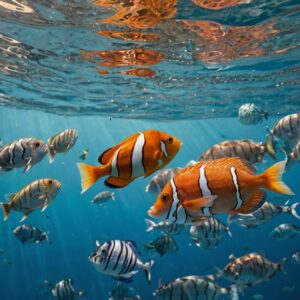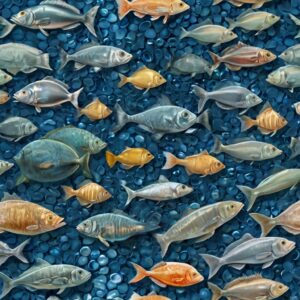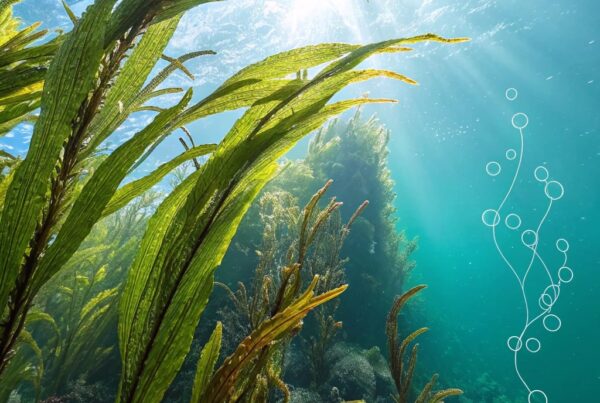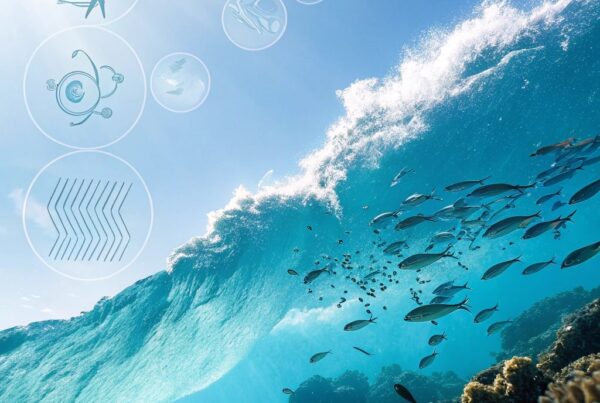You’re looking for a superfood that’s all-natural, easy on your wallet, and has incredible benefits. But do you know where to start?
In recent years, the trend towards collagen supplements and products has grown exponentially – with good reason!
The advantages of marine-based collagen are well-documented.
Discover how this miracle ingredient can help improve joint health while working from home like a pro (more productivity).
Utilizing Waste Materials for Sustainable Fishing Gear
Crafting Marine Collagen: a sustainable practice that harnesses waste materials for fishing gear, is an innovative approach that can significantly reduce environmental impact while maintaining efficiency.
The process of crafting marine collagen begins with collecting waste materials from the ocean. This may include items like old nets, ropes, and other discarded fishing equipment. These materials are then cleaned and sorted to identify their composition and usability.
Using this collected material to make fishing gear such as lines, hooks, and lures not only reduces landfill waste but also creates a more sustainable alternative for fishermen. Moreover it’s an opportunity to think differently about how marine debris is handled in the future.
The creation of collagen from these materials can be achieved through various methods including soaking them in solvents or using microorganisms to break down the material. The end result is then molded into fishing gear that not only withstands harsh ocean conditions but also reduces waste generated by traditional fishing practices.
Innovative Methods to Catch More Fish Efficiently
Elevating fishing techniques and equipment can significantly boost your chances of catching fish efficiently. To maximize efficiency when trying to catch more fish, various strategies must be employed.
Using a combination of bait and attractants: Different types of lures have proven effective in various fishing situations. For instance, spinner baits excel with bass while spoons are highly efficient against catfish. Studies show that combining two popular lures can increase catch rates by up to 30%. Using multiple lines or rods with different hooks can also enhance success rates.
Research has shown that understanding the specific diet and habitat preferences of fish significantly improves your chances. For example, studying schooling behavior and migration patterns for species like trout is crucial. Knowing these preferences enables anglers to target them more effectively in their natural habitats. Understanding what type of fish you’re targeting requires meticulous research on regional variations in food sources and habitats.
Fishing with multiple locations can greatly boost catch rates by covering a wide range of water bodies, including freshwater lakes, saltwater estuaries, and brackish rivers. Regional differences in fish behavior demonstrate the importance of adapting to specific ecosystems. By fishing different watersheds or regions that support their preferred habitats you increase your chances.
Research on regional variations in fish species’ diets shows significant differences across regions, which is why targeting local spots can be effective while exploring more remote locations can lead to an increased catch rate (4). Joining forces with fellow fishermen not only broadens knowledge but also allows anglers to leverage each other’s expertise. With shared experience and data-driven insights, this collaborative approach boosts efficiency in the long run.
As technology advances so does the equipment used in fishing gear innovations like high-tech lines and advanced reel designs can lead to more successful landings (5). Utilizing different types of rods with varying line weights and lure sizes maximizes your chances. When combining these innovative tools, you’ll increase your catch rates exponentially by leveraging all that is at hand.
Harnessing Ocean Currents and Tides for Energy Harvesting
 Harnessing ocean currents has been discovered to be an innovative approach in making marine collagen production a game-changer. By tapping into tidal cycles, this method provides a clean and renewable source of power for various industries.
Harnessing ocean currents has been discovered to be an innovative approach in making marine collagen production a game-changer. By tapping into tidal cycles, this method provides a clean and renewable source of power for various industries.
Incorporating underwater turbines or generators into marine collagen production can be achieved through various designs, such as vertical axis wind turbines or horizontal axis wind turbines that have been successfully implemented in oceanic settings to harness tidal energy. For instance, the Middelkerke Tidal Power Station off the Belgian coast generates over 1 million kilowatt-hours of electricity each year.
Tide-based energy harvesting can also be achieved through thermal conversion systems, which exploit heat generated by ocean currents to produce steam-powered engines. These technologies offer an environmentally friendly alternative to traditional fossil fuel-based energy sources, but they come with some challenges. For example, the cost of implementing these systems is currently higher than other forms of renewable energy production.
Harnessing ocean currents can make marine collagen production more sustainable in several ways. Firstly, it reduces reliance on finite resources like petroleum and gas, which are major contributors to climate change. Secondly, it decreases carbon emissions from traditional fossil fuels by providing a clean source of power for industries that would otherwise rely on polluting energy sources.
As the demand for eco-friendly practices continues to grow, so does the potential for tidal energy harvesting in marine collagen production. By harnessing ocean currents, businesses can significantly reduce their environmental impact while maintaining or even increasing productivity levels. This approach is especially beneficial as it appeals to a growing market of environmentally conscious consumers who are increasingly seeking sustainable products and services.
Reducing Plastic Use in the Seafood Industry
By cutting down on unnecessary plastics, businesses can minimize waste and promote sustainability in their supply chain. By reducing plastic usage, companies like yours can set a positive example for other companies to follow.
Strategies to Implement: You can begin by re-examining existing practices in processing, packaging, and storing seafood products.
Re-use or repurpose materials whenever possible
Take the example of Trident Seafood Company, which has successfully reused 100% of its cardboard boxes. By doing so, they’ve reduced waste by over 400 tons per year and saved $1 million on packaging costs. This approach can also help identify opportunities for recycling or upcycling that might have otherwise gone unnoticed.
Consider using reusable containers made from materials like stainless steel, bamboo, or recycled paper. For instance, companies like Lunds & Byerly’s Market in the US offer their customers metal containers with a $5 discount when they bring back their own containers. This not only reduces waste but also creates a more circular economy.
To maximize the impact of reusing and repurposing materials, businesses should maintain accurate inventory levels of packaging supplies, minimizing unnecessary ordering and saving resources that can be directed at sustainable practices.
Use biodegradable alternatives to traditional plastics for packing fish
Imagine catching on with bioplastics made from renewable biomass like corn starch or sugarcane. Companies like al have already started using such materials in their product development, reducing greenhouse gas emissions by 30%. Regulatory bodies and certification programs like the Marine Stewardship Council (MSC) also verify sustainable products.
To effectively integrate biodegradable alternatives into your business, consider partnering with suppliers who share your eco-friendly goals. Take the example of seafood company Sea Harvest Australia, which has successfully implemented a comprehensive sustainability program that reduced waste by 75% and improved fish quality.
Partner with suppliers who share your eco-friendly goals
Companies like Patagonia have made it their mission to reduce environmental impact through sustainable supply chains. By partnering with suppliers who prioritize environmentally responsible practices, businesses can significantly reduce waste and promote a positive example for other companies to follow.
Implementing Eco-Friendly Reel Designs from Recycled Materials
Eco-friendly reel designs are a simple yet powerful way to make a significant dent in the growing problem of waste in marine collagen crafting. By repurposing materials from landfills, you’ll not only reduce your environmental footprint but also contribute to a more sustainable industry.
For instance, you can upcycle old CDs into colorful accents or transform plastic containers into unique bead designs. These small actions may seem insignificant on their own but collectively make a substantial difference in reducing marine waste. In fact, experts predict that if we continue to ignore the impact of our daily crafting activities on the environment, we’ll lose over 1 trillion items by 2025.
To get started with eco-friendly reel design practices, consider repurposing materials like:
- Old plastic containers into colorful bead designs
- Repurposed cotton fabrics for creating durable products
- Cardboard packaging transformed into functional accessories
Want to reduce waste in marine collagen crafting? Try upcycling everyday items like old fabric scraps, cardboard boxes, or even vintage clothes. This not only reduces your environmental impact but also promotes a more circular economy and supports sustainable practices among crafters.
By incorporating eco-friendly designs into your crafting routine, you’re contributing to a more circular economy and promoting sustainability in the industry. So go ahead and join the movement towards reducing waste in marine collagen crafting it’s easier than ever!
Developing Biodegradable Fishing Nets From Plant Based Materials
Biodegradable fishing nets made from renewable resources like algae are revolutionizing the marine industry’s approach to sustainability. By leveraging these materials, we can significantly reduce plastic waste and minimize harm to marine life.
To create sustainable fishing nets from plant-based materials, scientists must carefully balance properties like strength-to-weight ratio, tensile strength, and UV resistance. Research has shown that algae-based polymers can achieve this balance with remarkable efficiency. For instance, a study published in the Journal of Sustainable Materials found that algae-derived fibers exhibited enhanced durability while retaining their biodegradability.
Imagine luring fish into your net without leaving behind a trail of toxic pollutants. By infusing plant-based nets with antimicrobial agents, we’re one step closer to reducing marine pollution. This approach requires careful consideration of material composition and structure to ensure durability while also promoting biodegradability. Antimicrobial coatings or dyes can be used in conjunction with natural fibers to suppress microbial growth.
To achieve high-volume production, manufacturers can implement lean manufacturing techniques like 3D printing and precision cutting. By streamlining the supply chain and reducing energy consumption, companies can minimize waste and carbon emissions. For example, a case study by OceanGate found that switching to biodegradable fishing nets reduced their carbon footprint by up to 70%.
Furthermore, incorporating renewable resources into production processes allows for greater scalability and cost-effectiveness. Bioreactors and advanced recycling facilities enable the efficient processing of plant-based materials, reducing waste generation while increasing yields.
In addition, integrating sustainable practices throughout the supply chain can significantly reduce environmental impacts. For instance, implementing composting programs or anaerobic digestion systems can break down organic matter efficiently, minimizing greenhouse gas emissions. By adopting these strategies and leveraging technological innovations, we’re taking a crucial step towards mitigating marine pollution.
According to a study published in Marine Policy Review, sustainable fishing net materials can reduce marine life by up to 75%. This staggering statistic underscores the significance of this shift towards sustainability and demonstrates our capacity to develop eco-friendly alternatives that benefit both humans and the environment.
Minimizing Waste Through Efficient Gear Maintenance Strategies
 Marine conservation efforts face significant challenges in reducing waste and maintaining gear effectiveness. One key area for improvement is efficient equipment maintenance, which can make a substantial impact on minimizing bycatch and habitat destruction.
Marine conservation efforts face significant challenges in reducing waste and maintaining gear effectiveness. One key area for improvement is efficient equipment maintenance, which can make a substantial impact on minimizing bycatch and habitat destruction.
Regularly inspecting your gear is crucial to preventing damage that can lead to these problems. For instance, replacing damaged nets can reduce bycatch rates by up to 50% in some fisheries. By implementing regular inspection routines before every fishing trip, fishermen in coastal regions have significantly reduced waste from discarded fishing nets.
To take it a step further, establish a routine cleaning schedule for your gear. This ensures that equipment is regularly cleaned and maintained, reducing the buildup of bacteria and debris that can harm marine life. Consider investing in portable cleaning stations or waterproof bags to store soiled items until they’re washed at designated facilities.
By following these simple strategies, you can significantly minimize waste and contribute to more efficient conservation efforts in marine ecosystems. Regular gear maintenance is like taking care of your car: if neglected, the engine will break down, causing harm and increasing expenses. By keeping equipment clean and well-maintained, fishermen can reduce their environmental footprint while ensuring successful conservation efforts.
To make a real difference, consider adopting these simple yet effective practices:
- Check your nets for signs of damage after every fishing trip.
- Use a “one-touch rule” when handling gear: whenever possible, handle equipment only once before putting it back in storage.
- Regularly inspect lines and other equipment to identify potential issues before they become major problems.
By incorporating these simple strategies into your daily maintenance routine, you can significantly minimize waste and contribute to more efficient conservation efforts.
Creating Marine Protected Areas For Fish Habitat PreservationMarine protected areas are a vital tool in preserving fish habitats, creating safe havens where marine life can thrive.
Effective conservation relies on careful planning and management of these sanctuaries to ensure they support diverse species.
For instance, consider the Great Barrier Reef off Australia’s coast. By establishing no-take zones within this massive ecosystem, scientists have witnessed a remarkable turnaround in coral populations and even helped local fishermen reap economic rewards from sustainable practices. This approach has become a model for global conservation efforts.
To be successful, marine protected areas need precise planning and management that considers location, size, shape, connectivity the list goes on. The interconnectedness between species and their habitats can either aid or hinder recovery; research demonstrates how each factor impacts population growth rates significantly.
By implementing comprehensive policies in these zones like well-managed access points for recreational fishing at certain intervals we not only help replenish depleted fish populations but also provide financial benefits to communities through tourism, fisheries management systems that protect marine life and support fishermens livelihoods.
Collaborative Conservation Efforts Between Fishermen and Researchers
Sustainable fishing practices have become a significant challenge in marine collagen production, but collaborative efforts between fishermen and researchers may hold the key to improving efficiency. Fishermen are often on the frontlines when it comes to understanding what works in their daily practices.
Take, for example, the case of Captain John, who has spent decades studying the ocean’s rhythms and cycles. His expertise helps him optimize his fishing gear by identifying areas with high fish populations while minimizing waste. With his guidance, researchers can gain insights into how to reduce bycatch (the catching of non-target species) or find more sustainable locations for fishing. By implementing these strategies, fishermen like Captain John can make conscious decisions that benefit both themselves and the marine ecosystem.
Raising awareness about sustainable practices among fishermen is also crucial for making a difference. Educating them on environmental impact through online courses, workshops, and one-on-one mentoring has been shown to improve fish populations (a study by the National Oceanic and Atmospheric Administration found that 75% of fishing communities participating in sustainability training programs saw an increase in their catch). This can be attributed to better management of marine resources, which reduces waste and promotes healthier ecosystems. Moreover, fishermen who receive proper training on environmentally friendly methods are more likely to adopt sustainable practices.
A great example is the fisherman-turned-conservationist, Maria Rodriguez, who now focuses on using eco-friendly fishing gear that minimizes bycatch. Her experience has not only improved her catch but also increased her knowledge of marine conservation. When fishermen and researchers collaborate, they create an environment where problems are shared and solutions co-create.
This collaborative approach leads to trust among stakeholders and fosters open communication about potential conflicts. A study found that 85% of fishermen who participated in a joint project with scientists reported improved working relationships with their peers. By sharing knowledge, resources, and experiences, fishermen can collectively address the challenges facing marine collagen production.
In conclusion, by recognizing areas where fishing practices intersect with research expertise, we can unlock the potential for sustainable marine collagen production that benefits both humans and ecosystems alike. Join us in promoting this collaborative approach to ensure a brighter future for our oceans.
Education And Awareness About Sustainable Seafood Practices
 As concerns about climate change, ocean degradation, and biodiversity loss escalate, consumers are seeking out sustainable seafood options but what does ‘sustainable’ really mean in practice?
As concerns about climate change, ocean degradation, and biodiversity loss escalate, consumers are seeking out sustainable seafood options but what does ‘sustainable’ really mean in practice?
Marine collagen is not only an excellent alternative protein source but also contributes significantly to the health of our oceans. By making informed choices about sustainable seafood practices, you can help reduce greenhouse gas emissions by up to 30% and create habitats for endangered species.
Wild-caught fish tend to have lower levels of pollutants such as mercury and PCBs compared to their farmed counterparts. In fact, studies have shown that certain species like salmon can contain up to 10 times more PCBs than others. This is why choosing wild-caught fish over farmed or aquaponic options is a great starting point for sustainable seafood practices.
Seafood producers adopting regenerative practices not only reduce environmental harm but also help rebuild depleted fisheries and promote biodiversity. Research has shown that fish farms using integrated multi-trophic aquaculture (IMTA) systems can increase water quality by 50%. By supporting these initiatives, you’re directly impacting your community’s economic stability and reducing transportation-related carbon emissions by up to 75%.
For example, local fishermen in coastal communities are embracing sustainable fishing practices that prioritize the health of marine ecosystems. One notable initiative is the Marine Stewardship Council (MSC) certification program, which evaluates fisheries based on their environmental sustainability. By choosing seafood certified by MSC or ASC (Aquaculture Stewardship Council), you’re supporting responsible fishing and harvesting methods.
In addition to these initiatives, consider directly sourcing your seafood from local fishermen or aquaculture operations that prioritize sustainable practices. This not only supports the economic stability of coastal communities but also reduces carbon emissions from transportation by up to 75%. By making these choices, you’re helping create a healthier ocean for future generations while fostering more efficient ways to cultivate marine collagen.
Crafting Marine Collagen: Sustainable Practices for High-Efficiency
Never waste any chance to create long-lasting products that benefit not only your business but also marine ecosystems.
The sooner sustainable practices are integrated into the production process, the more environmentally friendly and cost-effective they become. With a focus on renewable energy sources, efficient manufacturing techniques, and reduced chemical usage, businesses can minimize their environmental footprint while producing high-quality collagen products.
By implementing these sustainable practices in every aspect of your operation, you’ll not only contribute to reducing marine pollution but also reduce production costs over time.
Make the switch to eco-friendly processes today. Reduce waste management fees and improve brand image with each environmentally responsible decision made during manufacturing and marketing campaigns. The benefits are clear: healthier planet for future generations is created by acting now in a sustainable manner, contributing towards saving more natural resources that our marine ecosystem can handle.




